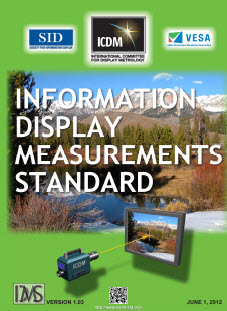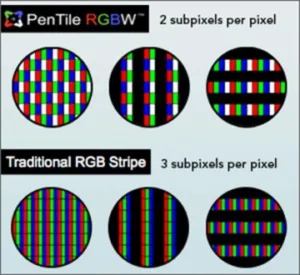There is a common misconception how resolution in a display is defined, “dot counting”, in which one examines the physical addressable architecture of a display, group a red, a green, and a blue subpixel, draw a box around it, and call it a pixel… then count the number of such boxes in the horizontal and vertical direction, columns and rows, voila! WRONG!

While one could, and many have, built displays with this definition in mind, this naïve architecture limits the display designer to one and only one architecture. It is a very poor design choice for high-resolution color displays, and ignores the true definition of resolution.
But if this isn’t the definition of resolution, what is?
Before we answer that, let’s consider some other types of displays that have no dots at all. Consider the Cathode Ray Tube (CRT). It has no dots. NO DOTS! So, if it has no dots, it has no resolution? That seems a silly result. A CRT is one component of a display system. It is the resolution of the complete system that we must measure. Let’s first consider a vector graphic system. It draws lines from one point to another, in a defined graphics space, on the screen. Its resolution could be limited by the number of points allowed in the vector space. But that’s not very useful.
Now, consider the classic raster scanned CRT. It has a defined number of scan lines, but the number of positions that are theoretically available in the horizontal scan are infinite, and only limited by the number of defined points that the system will attempt to address? No, not really. There is a limit to the horizontal resolution of a given CRT. But how do we define it and measure it? To help us answer that, lets go back to another system, a slide or movie projector. What is the resolution of the images projected onto a screen from a slide projector?
 The IDMS can be freely downloaded from SID – See P130 for the resolution measurementThe answer for all of the above is not the number of dots, obviously. The answer is the number of lines and spaces that may be RESOLVED. This definition of resolution may be applied to any and all display systems and is the one defined by the International Committee for Display Metrology (ICDM). (Note – the ICDM is freely downloadable from http://tinyurl.com/p9xp89d – Man. Ed.)
The IDMS can be freely downloaded from SID – See P130 for the resolution measurementThe answer for all of the above is not the number of dots, obviously. The answer is the number of lines and spaces that may be RESOLVED. This definition of resolution may be applied to any and all display systems and is the one defined by the International Committee for Display Metrology (ICDM). (Note – the ICDM is freely downloadable from http://tinyurl.com/p9xp89d – Man. Ed.)
At this point, I need to introduce the concept of image types, band-limited and non-band-limited. Photographs and videos taken with a camera are examples of that are band-limited. They have no spatial frequency components above a given resolution, typically just short of the Nyquist Limit for the system. Text, icons, and (non-photo-like) computer graphics are examples of non-band-limited images. Given that non-band-limited images have significant energy in spatial frequencies at (and often above) the Nyquist Limit of the system, the contrast at the resolution limit must be higher than for band-limited images to be meaningfully resolved. This too is found in the ICDM specifications in that for band-limited images, the Michelson Contrast at the resolution limit must be 25% or higher, while for non-band-limited images, it must be 50% or higher.
So, returning to subpixelated color display systems. Tell me again why we count the dots? We shouldn’t. Measuring the highest number of lines and spaces with the required minimum Michelson Contrast for the given image type is the correct way of defining the resolution of a given display system.
Another extremely naïve sentiment espoused by dot counters is that each box (“pixel”) must be independent and able to reproduce all colors, so it must contain a red, a green, and a blue. NONSENSE!
To understand why, we need to go back to the basics of what a display is for. In a very real sense, a display is an interface between two computers, one hardware, one wetware (the human brain). The display must be designed to interface with the human vision system through our eyes, particularly our retina, the light sampling neurons at the back, which takes in a color image and breaks it down into three perceptual channels before sending them on to the rest of the brain: the luminance, red/green chrominance, and the yellow/blue chrominance channels. These three channels have different resolutions. The luminance channel is the high resolution system, capable of resolving image spatial frequency information up to 60 cycles/degree. The red/green channel is limited to 8 cycles/degree, and the yellow/blue channel to only 4 cycles/degree. Thus, we can see that while we enjoy a display with high resolution in luminance, we simply can’t see high-resolution color information. We don’t need high resolution in color.
So, knowing this, it is perfectly permissible, advantageous even, to design a system that provides high resolution in the luminance, using subpixel rendering, while spreading out the color information by “borrowing” neighboring color subpixels to provide the full color information coming from the original image source. Again, each incoming full color “pixel” is fully represented, resolved, reconstructed, and color reproduced, using fewer than the dot counters’ defined three subpixels per pixel.
Again, while we could build a display with boxes with a red, a green, and a blue dot in each, there are better systems that provide higher resolutions for the number of colored dots. Several possible color subpixel layouts, when combined with subpixel rendering, that provide such higher resolution have been commercialized, now shipping in hundreds of millions of smartphones, tablets, notebook PCs, and TVs. Dot counters would have you believe that the consumer is being cheated. They are not.
Consider the RGBW PenTile architecture. It is capable of providing a specified high luminance resolution with high Michelson Contrast using only two subpixels per pixel ON AVERAGE as can be seen in the figure here. Candice H. Brown Elliot
![]()
Author: Candice H. Brown Elliott has spent the last 15 years leading international teams to develop and commercialize PenTile subpixel rendered displays. She founded Clairvoyante in 2000 for this purpose and sold it and the technology to Samsung in 2008, at which time she founded Nouvoyance to continue to develop the technology in close partnership with Samsung. Last year, the Society for Information Display awarded her the Otto Schade Prize for this work. She is currently consulting and is available for long term engagements, preferably in an executive role.

